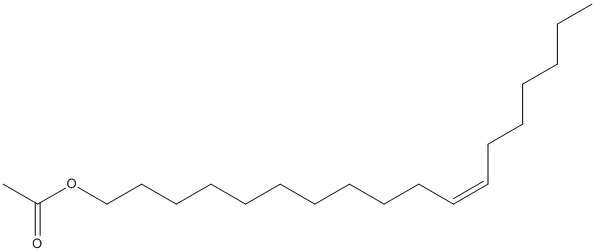cis-vaccenyl-acetate
General
Type : Odorant || Pheromone || Acetate
Chemical_Nomenclature : [(Z)-octadec-11-enyl] acetate
Canonical SMILES : CCCCCCC=CCCCCCCCCCCOC(=O)C
InChI : InChI=1S\/C20H38O2\/c1-3-4-5-6-7-8-9-10-11-12-13-14-15-16-17-18-19-22-20(2)21\/h8-9H,3-7,10-19H2,1-2H3\/b9-8-
InChIKey : QSZKEDWVAOAFQY-HJWRWDBZSA-N
Other name(s) : 11-cis-vaccenyl acetate, (Z)-Octadec-11-enyl acetate, cis-vaccenyl acetate, 11Z-Octadecenyl acetate, (11Z)-octadec-11-en-1-yl acetate
MW : 310.5
Formula : C20H38O2
CAS_number :
PubChem :
UniChem :
Iuphar :

Target
Families : Carb_B_Arthropoda
References (4)
| Title : Olfactory Landmark-Based Communication in Interacting Drosophila - Mercier_2018_Curr.Biol_28_2624 |
| Author(s) : Mercier D , Tsuchimoto Y , Ohta K , Kazama H |
| Ref : Current Biology , 28 :2624 , 2018 |
| Abstract : Mercier_2018_Curr.Biol_28_2624 |
| ESTHER : Mercier_2018_Curr.Biol_28_2624 |
| PubMedSearch : Mercier_2018_Curr.Biol_28_2624 |
| PubMedID: 30078566 |
| Title : Pleiotropic actions of the male pheromone cis-vaccenyl acetate in Drosophila melanogaster - Ejima_2015_J.Comp.Physiol.A.Neuroethol.Sens.Neural.Behav.Physiol_201_927 |
| Author(s) : Ejima A |
| Ref : J Comp Physiol A Neuroethol Sens Neural Behav Physiol , 201 :927 , 2015 |
| Abstract : Ejima_2015_J.Comp.Physiol.A.Neuroethol.Sens.Neural.Behav.Physiol_201_927 |
| ESTHER : Ejima_2015_J.Comp.Physiol.A.Neuroethol.Sens.Neural.Behav.Physiol_201_927 |
| PubMedSearch : Ejima_2015_J.Comp.Physiol.A.Neuroethol.Sens.Neural.Behav.Physiol_201_927 |
| PubMedID: 26105507 |
| Title : A carboxylesterase, Esterase-6, modulates sensory physiological and behavioral response dynamics to pheromone in Drosophila - Chertemps_2012_BMC.Biol_10_56 |
| Author(s) : Chertemps T , Francois A , Durand N , Rosell G , Dekker T , Lucas P , Maibeche-Coisne M |
| Ref : BMC Biol , 10 :56 , 2012 |
| Abstract : Chertemps_2012_BMC.Biol_10_56 |
| ESTHER : Chertemps_2012_BMC.Biol_10_56 |
| PubMedSearch : Chertemps_2012_BMC.Biol_10_56 |
| PubMedID: 22715942 |
| Gene_locus related to this paper: drome-aes06 |
| Title : A single class of olfactory neurons mediates behavioural responses to a Drosophila sex pheromone - Kurtovic_2007_Nature_446_542 |
| Author(s) : Kurtovic A , Widmer A , Dickson BJ |
| Ref : Nature , 446 :542 , 2007 |
| Abstract : Kurtovic_2007_Nature_446_542 |
| ESTHER : Kurtovic_2007_Nature_446_542 |
| PubMedSearch : Kurtovic_2007_Nature_446_542 |
| PubMedID: 17392786 |